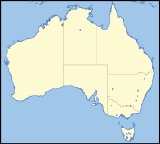
Alexander Morrison National Park
Encyclopedia
Alexander Morrison National Park is a national park in Western Australia
(Australia
), located 207 kilometres (129 mi) north of Perth
in the Shire of Coorow
along the Green Head-Coorow Road. It was named for Alexander Morrison
, the first Government Botanist of Western Australia.
breakaways over sandstone
s and shale
s of the Lower Jurassic
Cockleshell Gully Formation. Sand heath
s are the dominant vegetation, but the park also contains extensive stands of low woodland and mallee typical of the area, especially in the western parts of the park. Prominent eucalypt species in the area are Powder-barked Wandoo (Eucalyptus accedens
) and Mallalie (E. eudesmoides
), while the heaths are rich in species typical of the region and include rare species such as spiral bush (Spirogardnera rubescens). The northern variant of Banksia vestita
is also common.
The Environmental Protection Authority recommended in 1974 that a one-kilometre-wide strip of vacant Crown land on the south side of Green Head-Coorow Road be added to the reserve – however, this was not actioned.
Western Australia
Western Australia is a state of Australia, occupying the entire western third of the Australian continent. It is bounded by the Indian Ocean to the north and west, the Great Australian Bight and Indian Ocean to the south, the Northern Territory to the north-east and South Australia to the south-east...
(Australia
Australia
Australia , officially the Commonwealth of Australia, is a country in the Southern Hemisphere comprising the mainland of the Australian continent, the island of Tasmania, and numerous smaller islands in the Indian and Pacific Oceans. It is the world's sixth-largest country by total area...
), located 207 kilometres (129 mi) north of Perth
Perth, Western Australia
Perth is the capital and largest city of the Australian state of Western Australia and the fourth most populous city in Australia. The Perth metropolitan area has an estimated population of almost 1,700,000....
in the Shire of Coorow
Shire of Coorow
The Shire of Coorow is a Local Government Area located in the Mid West region of Western Australia, about north of Perth, the state capital, and about south of the city of Geraldton. The Shire covers an area of and its seat of government is the town of Coorow, with the largest settlement being...
along the Green Head-Coorow Road. It was named for Alexander Morrison
Alexander Morrison (botanist)
Alexander Morrison was the first Government Botanist of Western Australia.Born in Western Dalmeny, Scotland, he began a medicine degree at Edinburgh, but suffered from ill health, prompting him to break his studies and visit Australia. He spent two years in Melbourne before returning to Edinburgh...
, the first Government Botanist of Western Australia.
Description
The park contains sandplains and low lateriticLaterite
Laterites are soil types rich in iron and aluminium, formed in hot and wet tropical areas. Nearly all laterites are rusty-red because of iron oxides. They develop by intensive and long-lasting weathering of the underlying parent rock...
breakaways over sandstone
Sandstone
Sandstone is a sedimentary rock composed mainly of sand-sized minerals or rock grains.Most sandstone is composed of quartz and/or feldspar because these are the most common minerals in the Earth's crust. Like sand, sandstone may be any colour, but the most common colours are tan, brown, yellow,...
s and shale
Shale
Shale is a fine-grained, clastic sedimentary rock composed of mud that is a mix of flakes of clay minerals and tiny fragments of other minerals, especially quartz and calcite. The ratio of clay to other minerals is variable. Shale is characterized by breaks along thin laminae or parallel layering...
s of the Lower Jurassic
Early Jurassic
The Early Jurassic epoch is the earliest of three epochs of the Jurassic period...
Cockleshell Gully Formation. Sand heath
Heath (habitat)
A heath or heathland is a dwarf-shrub habitat found on mainly low quality acidic soils, characterised by open, low growing woody vegetation, often dominated by plants of the Ericaceae. There are some clear differences between heath and moorland...
s are the dominant vegetation, but the park also contains extensive stands of low woodland and mallee typical of the area, especially in the western parts of the park. Prominent eucalypt species in the area are Powder-barked Wandoo (Eucalyptus accedens
Eucalyptus accedens
Powder-barked Wandoo is a eucalypt native to Western Australia. Mature trees are around 15–25 m high with branches high up the trunk....
) and Mallalie (E. eudesmoides
Eucalyptus eudesmoides
Mallalie is a rounded, bushy, mallee eucalypt native to Western Australia. Mature trees are usually 2–3 m high, occasionally up to 6 m...
), while the heaths are rich in species typical of the region and include rare species such as spiral bush (Spirogardnera rubescens). The northern variant of Banksia vestita
Banksia vestita
Banksia vestita, commonly known as Summer Dryandra, is a shrub endemic to Western Australia. It was known as Dryandra vestita until 2007.-Description:...
is also common.
History
Land for the national park was set aside by the Department of Lands and Surveys under Reserves ↑26800, ↑26803 and ↑26804 on 23 May 1969, and over 1970 and 1971, the land was classified as an "A" Class reserve, meaning its purpose could not be changed except by an Act of Parliament, and vested in the National Parks Authority of Western Australia. The park was officially named on 8 October 1971.The Environmental Protection Authority recommended in 1974 that a one-kilometre-wide strip of vacant Crown land on the south side of Green Head-Coorow Road be added to the reserve – however, this was not actioned.

